Educating Customers on Protecting Their Roof Against Storm Damage
Author: Dan Stout | August 7, 2024
Homeowners don't want to spend any more on a roof than they need to. And who can blame them? Roofs aren't inexpensive, and if we as roofers can deliver a quality product at a reasonable cost, many homeowners will want the least expensive option.

But part of our job is also to help clients understand why short-term savings may end up costing much more in the long run, especially when extreme weather and storm damage strikes.
We've gathered tips and tactics to help you explain the risks your customers face from storm damage, and how to mitigate those risks with resilient roofing material.
Local Customers, Local Conditions
Dealing with any customer is a unique experience. While some customers are fully on board with the concept of weather-resistant roofing, others struggle to see past the contract price.
The key to explaining the challenges roofing faces in a tough environment is to tailor your explanations to your local weather conditions. There's no point in talking about extensive UV exposure in cloudy Seattle or rooftop snow removal in Louisiana.
Your job will be to dive into the specific climate your customer's roof will face. This article will arm you with information addressing the most common storm-related issues nationwide: damage from high winds, impacts and water penetration.
High Winds
Wind resistance is obviously a concern in hurricane-prone areas such as Florida, or in tornado-prone areas like Kansas City. But even if your customers won't face tornadoes and hurricanes, they'll still have to contend with storms that bring driving winds, pushing rain beneath shingles and into even the smallest cracks.
When explaining wind-resistant options, remember that your customer is relying on you to translate the various ratings and code requirements. Chances are, you understand the difference between ASTM D7158 and ASTM D3161 wind ratings, but to the average homeowner that's simply a lot of letters and numbers. Describe their options in plain, easy-to-understand terms, and most homeowners will be far more comfortable choosing an upgrade.
Physical Impacts
Storm-related physical impacts tend to be from one of three sources: hail, falling tree limbs and wind-blown debris. Here are some tips on how to explain the risks for each.
Hail
Hail is the most common culprit when it comes to physical impact damage on a roof, and can spring up unpredictably in the middle of a storm season. Hail can damage almost any type of roofing, gouging holes in asphalt shingles or EPDM sheets and cracking harder materials such as slate or clay tiles.
To explain the risk of hailstorms, it's helpful to have hard facts. Use NOAA's Storm Events Database to find frequency and severity in your area.
Tree Limbs
A tree limb can theoretically fall at any time, though it's far more likely to happen during a windy storm. Luckily, this is the easiest physical impact to predict. If the customer has a large tree overhanging a roof, for example, then you shouldn't have much trouble explaining the risk that comes with it.
Give the owner guidance on the added cost to protect the roof from potential tree damage. Many homeowners love having large shade trees on their properties. Explain to them that there is a trade-off involved in having that big, beautiful shade tree — the homeowner can either pay to have the tree trimmed regularly or install impact-resistant roofing material. (Or they can simply accept the fact that they're going to have roof damage. But who wants to do that?)
Wind-borne Materials
In extreme wind conditions, normally benign material can become dangerous projectiles, hurtling into a roof and damaging the roofing or siding. This kind of damage can be very difficult to predict since it can come in so many forms. But this is exactly why homes in tornado and hurricane zones benefit from impact-resistant materials.
Water Penetration
Even a roof that typically doesn't show visible signs of leaks can suffer water damage during a storm, as high winds can drive water beneath shingles and into nearly unnoticeable cracks along flashing or at seams.
To defend against water penetration, offer upgrade options such as more robust ice and water underlayment.
Hands-on Education
One of the best ways to help a customer understand the difference in strength and durability of storm-resistant roofing is to provide samples. For many homeowners, actually holding the material in their hand is what finally brings home the added protection provided by resilient roofing materials.
Contact your local Beacon vendor if you'd like to get samples or more information to help educate homeowners.